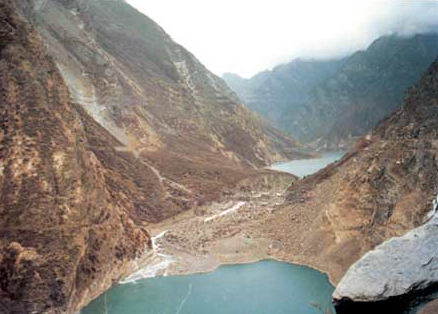Headlines and Hashtags
Qian Gang: China's history of catastrophic 'quake lake' floods should be a warning to leaders
By David Bandurski — While the initial dangers of the Sichuan earthquake seem to have passed, the area continues to be rocked by aftershocks, landslides and mud and rock flows that endanger survivors and rescue workers. In his latest column on the Wenchuan quake, CMP director Qian Gang re-visits the Diexi earthquake of 1933 and the lessons it holds for today.
“’Bursting ‘earthquake lakes’ send us a warning through history”
Qian Gang (钱钢)
A magnitude 8.0 earthquake, powerful aftershocks and massive landslides and mud and rock flows superimposed on one another have made the Wenchuan earthquake extremely destructive. Many rivers have been obstructed, resulting in at least 21 barrier lakes in the area. These lakes are large and their water levels high. In some areas, destroyed homes have already been submerged. Disaster relief headquarters has already ordered a thorough investigation of these barrier lakes. The Ministry of Water Resources, armed hydroelectric police units and experts organized by the Sichuan provincial government are closely watching the situation.
The largest barrier lake collapse in China in the last century had cataclysmic results. Well-known Chinese earthquake forecasting expert Geng Qingguo (耿庆国) observed the disaster scene at that time first-hand, and he wrote about it in “The Collapse of ‘Earthquake Lakes’: The 1933 Diexi Earthquake” (published in the book One-hundred Major Disasters in 20th Century China/二十世纪中国重灾百录).
[ABOVE: Image of remains of the Diexi barrier lake, from the Science Museums of China website.]
Notice the name of this place – Diexi. Diexi is a town in Sichuan’s Mao County (茂县), and it falls within the area of today’s major quake. At 3:50 pm on August 25, 1933, a magnitude 7.5 earthquake struck Diexi, with an epicentral intensity of X. The town of Diexi was entirely destroyed. As is the case in Wenchuan, the Diexi quake brought massive landslides at three points in Diexi, obstructing the Minjiang River (岷江). Eleven days after the earthquake a lake had appeared high up in the gorge. The water in the lake stretched back more than 12 kilometers, and at its widest point it was two kilometers across. It had become a major lake.
45 days after the quake, at 7pm on October 9, 1933, powerful aftershocks burst the barrier lake. The water gushed forth from the lake, tearing away the steep slopes on either shore and sending towering floodwaters rushing down the valley.
Geng Qingguo leaves us the following startling account:
“The waters gushed forth at 7pm, reaching Mao County by 9pm, Weizhou (威旧) by 11pm, reaching Wenchuan (汶川) by midnight and Guan County (灌县) by early the next day . . . “
These historical records reveal that the Wenchuan earthquake region of today was in fact in the past wiped out by the catastrophic bursting of a barrier lake caused by a quake. And the bursting of that barrier lake 75 years ago reminds us of the immense secondary dangers posed by earthquakes. In the Diexi earthquake itself, an estimated 7,000 lives were lost, but in the secondary bursting of the barrier lake 20,000 people died. 4,000 corpses alone were pulled out of Dujiangyan.
The aftershocks of today’s Sichuan earthquake have not yet ceased, landslides and mud and rock flows are still occurring, and precipitation is still building. Those 20 or so barrier lakes are ticking time bombs. I hope engineering experts conduct further inspections in order to fully understand the potential dangers, and take effective measures, diverting water and ensuring the safety of survivors and rescue workers in the disaster area.
I once worked at the China Earthquake Administration’s China Disaster Reduction Press. The editor in chief was Geng Qingguo. He is a scientist who has devoted his life to the study of earthquake prediction, and in The Great Tangshan Earthquake I make many references to his work. After the Wenchuan quake occurred, I recalled that when I was working together with Mr. Geng, I often heard him talking with other earthquake experts about a place called “Maowen” (茂汶). This, in fact, was Mao County and Wenchuan. In 1958 they were merged into the Maowen Qiang Autonomous County (茂汶羌族自治县). This is an area earthquake specialists in China have long paid attention to.
Probing deeply into this massive earthquake will be the work of many days. At present, relief work goes ahead under precipitous circumstances, as the barrier lakes are raised like swords overhead. By recalling the historical facts of the Diexi quake, I want only to encourage those leading the relief effort to be watchful!
[Posted By David Bandurski, May 23, 2008, 1:47pm]
FURTHER READING:
“Rains threaten China quake lake disaster“, Reuters, May 23, 2008
“Rain forecast for SW China, adding to ‘quake lake’ risks“, People’s Daily, May 22, 2008























